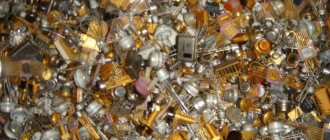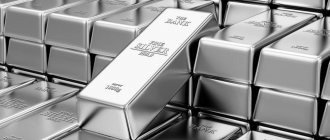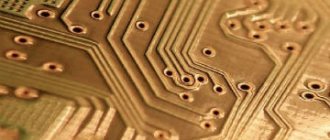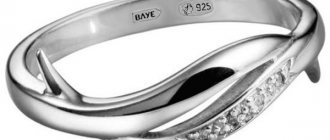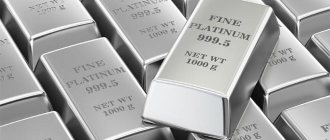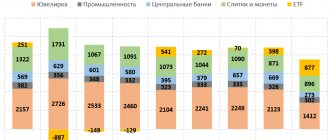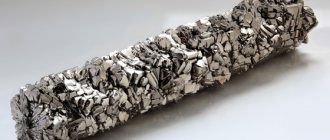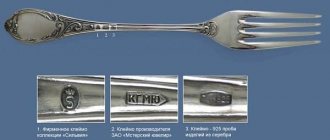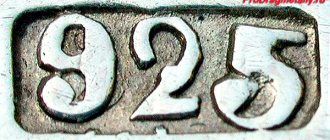Some hundred years ago, element 46 of the periodic table - palladium - did not have the same value as other rare metals.
Even in the 90s of the last century, when household refining of secondary precious metals was at the peak of popularity, palladium was of little interest to miners, unlike platinum, gold and silver.
The picture has changed dramatically now.
The metal belongs to the platinum group. Finds application in various industries. This is first of all:
- aerospace and military direction;
- automotive industry (production of catalysts for all types of transport);
- electronics;
- medicine.
Research is actively underway to expand the practical application of this element.
Thanks to this excitement, the price of palladium has increased significantly . Today, the cost of this element varies between 1 – 2 thousand rubles per 1 g. This fact, in turn, makes palladium refining an attractive undertaking from the point of view of economic benefits.
The metal is actively traded on world exchanges. It has a favorable prospect for long-term investment.
Precious metals in microcircuits
The first thing you need to pay attention to is the microcircuits of electronic household appliances. The materials they contain are necessary for the conduction of electric current, the formation of sufficient resistance and the normal functioning of the chips. In order to mine such an amount of gold that you can earn an amount that covers the cost of processing the parts, you need to stock up on a large number of microcircuits.
Soviet-made ceramic capacitors contain tantalum and silver elements, transistors and LEDs contain gold, as do switches, connectors, relays and potentiometers. Metal parts contain many alloys, including:
- gold;
- platinum;
- silver;
- tantalum;
- palladium;
- ruthenium.
Precious metals miners often have difficulty buying up chips. After all, the bulk of such Soviet-made devices have already been sold. And in order to extract 5 g of silver and 1 g of gold, you need to sort through at least one thousand parts. In some cases, the actual amount of precious substances differs from that indicated in the directory. Gold and silver content in certain microcircuits:
- K537RF - 40.1 and 71.2 g;
- 1200TSL1 - 43.3 and 115.1 g;
- 2FV2000 - 41.7 g of yellow metal, no silver;
- 530ID7 - 28.5 and 26.7 g;
- KM132RU2 - 34.7 and 52.6 g.
Microchips are rarely chosen for mining precious substances. Several parts on the list contain microscopic fractions of palladium. If the composition contains gold, the chip will have a characteristic yellow tint.
What radio components does it contain?
Before refining this precious metal, it is necessary to have information about which devices contain the largest amount of Pd.
Speaking about equipment, of course, we mean the radio components that make up their design.
From the total number, capacitors marked “KM” and a digital designation from 3 to 6 are distinguished as elements with the highest palladium content.
These parts are highly valued by buyers - you don’t have to refining radio parts containing palladium, but hand them over in their “pristine” form.
Capacitors of this class, encased in a ceramic case, are used in the production of motherboards for mobile devices, computers, and household appliances.
In addition, the following devices are of interest :
- oscilloscopes;
- generators;
- meters;
- analyzers;
- frequency meters and voltmeters;
- resistors and switches.
We suggest looking at the table, which indicates which radio components contain palladium, and how much of it is there:
| Item name | Palladium percentage (%) |
| Spirals and wires from reohords (recorders) marked “KSP”, “KSU”, “KSD” and potentiometers “PTP”, “PPML”. | 80 |
| Contacts from the dismantled switch "KSP" | 78 |
| The rheochord removed from the potentiometer “PPML IM-5” is “black wire”. | 60 |
| Slider (contact) removed from resistors “SP5”, “SP3-37”. | 58 |
| The needles removed from the contact group of the SP5-1V and SP3-37 resistors, as well as the strings of the MKS blocks, contain the same amount of palladium. | 28 |
| The wire used in the resistor rollers, as well as the contact group of the same device, is marked “PP3” and has a digital designation from 40 to 47. | 20 |
| Contact areas, SP5 circles. | 18 |
Transistors, thyristors, and other semiconductor devices that contain palladium are not of great interest , since there is very little of it there . Therefore, these devices are not included in the table, since refining Pd from these devices is an unprofitable undertaking.
Capacitors and resistors
Like microcircuits, the content of precious metals in capacitors is higher if they are made in the Soviet Union. In addition to silver and gold, platinum and palladium can be extracted from such elements. But recently, the amount of valuable substances has been decreasing due to the high cost of production. The demands placed on modern products today sometimes preclude the use of traditional materials.
If you are interested in which capacitors contain precious metals, then all parts are divided into several categories depending on the volume of gold, silver and platinum:
- ceramic with the KM brand;
- with a yellow body;
- tantalum;
- with silver coating.
You can get gold and silver from computers, automatic telephone exchanges and electronic devices that were produced in the USSR. For example, in the K 22 5 capacitor the content of precious metals is as follows - 34.2 g of gold and 52.3 g of silver. Tube TVs, tape recorders and other household appliances of that time can also be useful.
Not only capacitors and microcircuits contain valuable elements. They are also obtained from resistors. But they contain a lot of silver, and practically no gold and platinum. Experts pay special attention to Soviet potentiometers of the PTP, 5K, PPML and PPBL series. Models manufactured before 1982 are suitable. It is advisable that they be marked “Rhombus”.
Precious metals are extracted from these parts using a chemical method. You will need to prepare solutions of nitric and hydrochloric acid. A capacitor, microcircuit or resistor is placed in the mixture for 30-40 minutes and wait for the substances to separate. The sediment that appears at the bottom of the container may have a red or brown tint - this is gold. It is collected and washed, then melted into jewelry or other products.
Prices for capacitors containing precious metals
The cost of 1 kg of capacitor marked KM reaches 70,000 rubles. 40,000 rub. You can get it for 1 kg of KM-5D series capacitor. Red capacitors of the KM-N30 brand cost 35,000 rubles/kg.
The most expensive transistors are KT907, KT970A, sharpened for a yellow bolt. Price - 30-40 rubles. a piece. Also, the demand among resellers for variable resistors is growing. They give 5-10 rubles. a piece. You can also submit relays of certain series and years. Included in the price: connectors with gold-plated contacts. The more of them with a yellow tint the buyer can find, the higher the final price.
Types of capacitors with precious metals that are accepted at purchase points
Don't throw your old electronics into a landfill.
After all, buying precious metals in radio components is a profitable business, a good profit for both parties to the transaction. ◄Back to articles
Gold in connectors
Connectors are considered a rich source of precious materials. You can buy them by weight. Both Soviet and imported models are suitable for gold and silver mining. The year of manufacture does not matter. Some radio components contain quite a lot of palladium. In order to find out whether it really is in the composition, the element must be set on fire. If, as a result, dark spots appear on the connector, then you can remove the precious metal.
One kilogram of these parts usually contains up to 25 g of pure gold. Chinese and American connectors are poorer sources, containing five times less precious metals. It is easy to extract the substance from the elements. To do this, you need to prepare a chemical reagent called “Royal Vodka”. It contains a 30% solution of hydrochloric acid and 40% nitric acid. They are mixed in a 3:1 ratio, poured into a pre-cooled container and mixed thoroughly and slowly.
Connectors are placed into the mixture, and the gold is separated from the other elements in their composition. The liquid turns yellow and smells like chlorine. It must be used immediately after production, since after 1-2 days it will lose its properties and become harmful to human health.
The oxidizing agent will separate the gold, platinum and palladium. During operation, the mixture releases vapors that can cause poisoning and internal burns. They must not be inhaled, and the room where the work is carried out must be ventilated. Silver, chromium and zirconium cannot be extracted this way. A thick coating of chloride forms on the surface of these materials. Noble metals will not be affected in this way.
Modifications of KM capacitors
The following modifications of capacitors were made: KM-3, KM-4, KM-5, KM-6.
KM-4, KM-5, KM-6 - there can be 1 or 2 types, KM-3 - only 2 types.
Design options:
- non-isolated, multi-directional terminals: KM-3a, KM-4a, KM-5a - non-isolated, unidirectional terminals: KM-3b, KM-4b, KM-5b - isolated, unidirectional terminals: KM-3b, KM-4b, KM- 5b, KM-6(a, b) - unprotected: KM-3v, KM-4v, KM-5v
Range of nominal capacities:
KM-3 680 pF - 22 nF KM-4 16 pF - 47 nF KM-5 16 pF - 0.15 µF KM-6 120 pF - 2.2 µF
Distribution of CM by rated voltage value (V) and TKE groups:
| TKE | P33 | MPO | M47 | M75 | M750 | M1500 | H30 | H50 | H90 |
| KM-3 | 250 | ||||||||
| KM-4 | 250 | 250 | 250 | 250 | 160 | 160 | 100 | ||
| KM-5 | 160 | 160 | 160 | 160 | 100 | 100 | 50 | 50 | |
| KM-6-a | 50 | 50 | 50 | 50 | 35 25 | 35 25 | 35 25 | 35 25 | |
| KM-6-b | 50 | 50 | 50 | 50 | 35 25 | 35 25 | 35 25 |
Features of transistors
Not all transistors contain precious metals. But there are some household appliances that contain parts with gold and palladium. Most popular elements:
- 2T306 series A, B, V, G;
- 2T355A;
- 2Т509А;
- 2T603B;
- 2Т944А;
- 2Т998А.
The minimum amount of gold that can be obtained from them is 10.8 g, the maximum ranges from 26.4 to 33.43 g. Some parts also contain silver in the amount of 273-519 g and a small amount of palladium. Some models contain up to 1 g of platinum.
The content of precious substances is determined by the color of the contacts. If they are yellow, that is gold, red - copper, silver - silver, white - platinum. To extract them, you need to remove the housing from the transistor, disassemble all the parts and clean the insulation from the contacts. Using a chemical method using a solution of hydrochloric and nitric acid, the precious material is isolated and purified.
Radio components with precious metals on boards
Not every board can be removed from radio components and handed over to a collection point. Today, buyers do not accept payments from industrial equipment and televisions. Moreover, the boards are assessed by the markings of valuable parts on each of them. The weight of the boards itself is not taken into account.
Types of capacitors with precious metals that are accepted at purchase points
Boards from cell phones, RAM measuring instruments with gold-plated contacts, microcircuits, KM capacitors, old-style computers, and switching devices are accepted for delivery. Processors come first in cost. The price for 1 kg reaches 8,000 rubles. Then come the RAM modules. You can get 1500 rubles per piece. Electronic scrap is also subject to acceptance: radio components with precious metals, computer motherboards, sound and video cards, hard drives.
Sell capacitors
Relay characteristics
Specialists of the Soviet Union used high-quality materials to produce household appliances and computers. Precious materials were often used. They are contained in significant quantities in the relay. Miners are recommended to use parts from the following series:
- RP and RES;
- RKN and RPS;
- RKP and RKM;
- RTN and TRSM;
- TRT and TRP.
Additionally, you need to check the relay with an aluminum housing, since it is necessary to reach the contacts. The presence of silver or platinum is determined by their color.
Even in Soviet times, radio amateurs mined gold from electronics. They learned that the significant content of precious metals in the capacitor is the 1st source in terms of their quantity in technology. This method of earning money remains relevant to this day. With the right choice of parts, you can accumulate your own small capital, because gold, since its inception, has always played the role of hard currency.
Where are capacitors with precious metals used?
There are different types of devices. They are divided into polar and non-polar. The manufacturing materials are glass, glass ceramics, and synthetic materials. By type of device there are: film, high-voltage, low-voltage, oxide-semiconductor, mica, electrolyte, foil, oxide-metal.
Sell capacitors
There are products in various technologies and equipment: radios, radios, printers, scanners, measuring instruments, and other radio devices.
